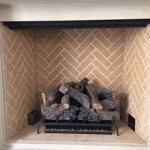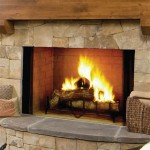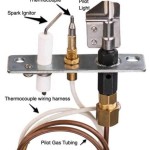The Enduring Charm of a Homemade Fireplace Mantel
A fireplace serves as a focal point in many homes, providing warmth and a sense of comfort. The mantel, positioned above or surrounding the fireplace opening, contributes significantly to the overall aesthetic. While commercially manufactured mantels are readily available, the creation of a homemade fireplace mantel presents an opportunity for personalization, cost savings, and the unique satisfaction of crafting a bespoke element for one's living space.
The construction of a homemade fireplace mantel involves several key considerations, including design, material selection, structural integrity, and adherence to safety regulations. A well-planned and executed mantel not only enhances the visual appeal of the fireplace but also provides a functional surface for displaying decorative items or supporting electronic devices.
Planning and Design Considerations
Before commencing the construction process, a detailed plan is crucial. This initial phase involves assessing the existing fireplace structure, determining the desired style and dimensions of the mantel, and selecting appropriate materials. The design should complement the overall architecture of the room and reflect the homeowner's personal preferences.
Consider the fireplace’s existing style. Is it a traditional brick fireplace, or a more modern, streamlined design? The mantel's style should harmonize with the existing structure. A rustic, reclaimed wood mantel might suit a brick fireplace, while a sleek, minimalist mantel could enhance a contemporary design.
Accurate measurements are essential. Determine the width and height of the fireplace opening, the desired depth of the mantel shelf, and the overall height of the mantel. Consider the proportions of the room and ensure that the mantel does not overwhelm the space. It's advisable to create a scaled drawing or model to visualize the final product.
The functionality of the mantel also plays a critical role in the design process. Will the mantel serve primarily as a decorative element, or will it be used to support heavy objects, such as a television or sound system? If the mantel will bear significant weight, the design must incorporate adequate structural support to prevent sagging or collapse.
Building codes and safety regulations must also be considered during the planning phase. Local building codes often specify minimum clearances between the fireplace opening and combustible materials. Adhering to these regulations is essential to prevent fire hazards. Consult with local authorities or qualified professionals to ensure compliance.
Material Selection and Construction Techniques
The choice of materials significantly impacts the appearance and durability of the fireplace mantel. Wood is a popular choice due to its versatility, availability, and aesthetic appeal. However, other materials, such as stone, concrete, and metal, can also be used to create unique and visually striking mantels.
For wood mantels, consider the type of wood, its grain pattern, and its suitability for finishing. Softwoods, such as pine and fir, are relatively inexpensive and easy to work with, but they may be more susceptible to dents and scratches. Hardwoods, such as oak, maple, and cherry, are more durable and offer a richer appearance, but they are typically more expensive and require more specialized tools for cutting and shaping.
Reclaimed wood is a sustainable and aesthetically appealing option for creating a rustic or vintage-style mantel. Reclaimed wood often possesses unique character and imperfections that add to its charm. However, it's essential to ensure that reclaimed wood is properly cleaned and treated to remove any contaminants or pests.
Stone and concrete mantels offer a more substantial and fire-resistant option. These materials can be used to create a variety of styles, from traditional to contemporary. Stone mantels can be constructed from natural stone, such as granite or marble, or from manufactured stone veneer. Concrete mantels can be cast in place or pre-cast and then installed on site.
Metal mantels, typically constructed from steel or aluminum, offer a sleek and modern aesthetic. Metal mantels are often used in contemporary homes with a minimalist design. They are durable, fire-resistant, and can be finished in a variety of colors and textures.
Once the materials have been selected, the construction process can begin. This typically involves cutting the materials to the required dimensions, assembling the mantel frame, and attaching the mantel shelf. The construction techniques will vary depending on the type of material being used and the complexity of the design.
For wood mantels, common construction techniques include using screws, nails, and adhesives to join the various components. It's essential to use high-quality fasteners and adhesives to ensure a strong and durable bond. Woodworking tools such as saws, drills, and sanders are essential for shaping and finishing the wood.
For stone and concrete mantels, specialized tools and techniques may be required. Stone cutting tools, such as diamond saws and grinders, are used to shape and cut the stone. Concrete mixing and casting equipment are necessary for creating concrete mantels. These materials can be heavy and require careful handling during installation.
Installation and Safety Considerations
The installation of the fireplace mantel is a critical step that requires careful attention to detail and adherence to safety regulations. A properly installed mantel should be securely attached to the fireplace structure and should be able to withstand the weight of any objects placed on it.
Before installing the mantel, ensure that the fireplace structure is sound and free from any cracks or damage. If necessary, repair any damaged areas before proceeding with the installation. The mantel should be securely attached to the fireplace using appropriate fasteners, such as screws, bolts, or masonry anchors.
The type of fasteners used will depend on the type of fireplace structure and the material of the mantel. For brick or concrete fireplaces, masonry anchors are typically used to provide a secure connection. For wood fireplaces, screws or bolts can be used to attach the mantel to the studs or framing behind the fireplace surround.
The mantel’s placement is paramount. It should be positioned at a safe distance from the fireplace opening to prevent combustible materials from catching fire. Local building codes specify minimum clearances between the fireplace opening and combustible materials. These clearances should be strictly adhered to.
A non-combustible material, such as tile or stone, can be used to create a fire-resistant barrier between the fireplace opening and the mantel. This barrier should extend beyond the edges of the fireplace opening to provide adequate protection.
After the mantel has been installed, it should be thoroughly inspected to ensure that it is securely attached and that all safety regulations have been met. Test the mantel's stability by applying pressure to various points to ensure that it does not wobble or shift. If any issues are identified, they should be addressed immediately.
Wiring for electrical outlets or lighting fixtures should be installed by a qualified electrician. All wiring should be properly insulated and grounded to prevent electrical hazards. Ensure that all electrical connections are concealed and protected from heat and moisture.
Maintenance is also an important aspect of ensuring the longevity and safety of the fireplace mantel. Regularly inspect the mantel for any signs of damage, such as cracks, warping, or loose fasteners. Clean the mantel regularly to remove dust and soot. For wood mantels, consider applying a protective coating to prevent damage from moisture and sunlight.
By carefully planning the design, selecting appropriate materials, and adhering to safety regulations, homeowners can create a beautiful and functional homemade fireplace mantel that enhances the ambiance of their living space. The satisfaction of crafting a bespoke element for one's home is an added benefit that makes the project even more rewarding. Remember to consult with qualified professionals if you are unsure about any aspect of the design or construction process. Prioritizing safety throughout the project is of utmost importance.

How To Make An Easy Diy Fireplace Mantel Sprucing Up Mamahood

Diy Fireplace Mantel Designatedspacedesign Com

Diy Rustic Fireplace Mantel The Cure For A Boring
:max_bytes(150000):strip_icc()/sandandsisal-bdc76ad938a44d28ae9e23ef6c9fa331.jpg?strip=all)
17 Diy Fireplace Mantel Plans

How To Build A Fireplace Mantel Easy Diy Blossoming Life

How To Make A Diy Fireplace Mantel The Idea Room

Diy Fireplace Mantel Making It In The Mountains

Diy Fireplace Mantel And Surround Jenna Kate At Home

Easy Diy Fireplace Mantel Tutorial Jessica Welling Interiors

Easy Fireplace Mantel Diy
Related Posts








